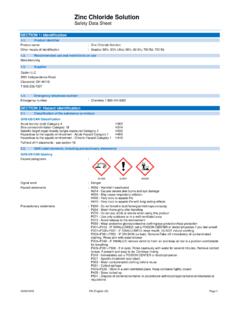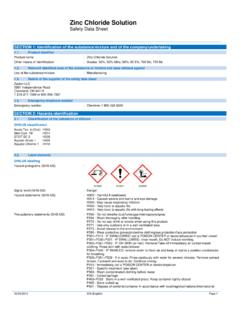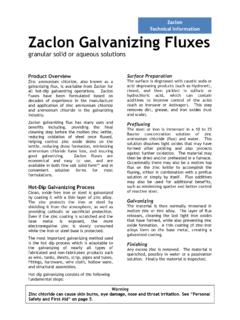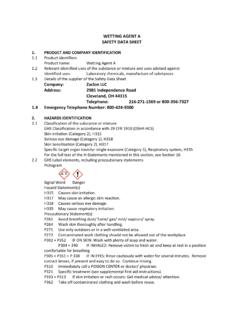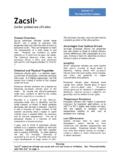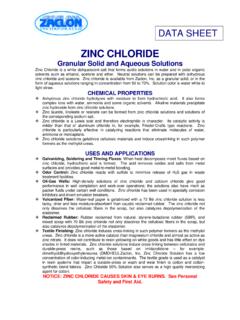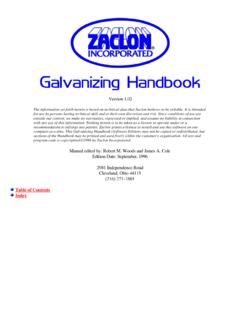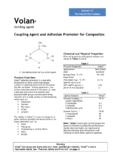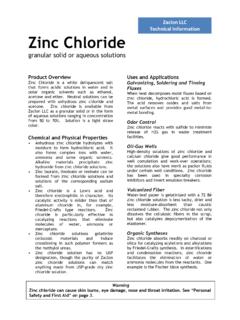Transcription of Quilon Data Sheet - ZACLON - Making Quality …
1 Quilon Products Product Overview Quilon is a dark green solution, largely in isopropanol, of a chemically reactive complex in which a C14-C18 fatty acid is coordinated with trivalent chromium. Seven grades are available: Quilon C, M, S; higher-strength Quilon H, L, and C-9. Quilon reacts with polar groups on paper, leather, nonwovens, woven fabrics, polymers, and other negatively charged surfaces. When cured, Quilon forms an insoluble layer of polymerized complex that is chemically bounded through chromium to the available polar groups on the substrate surface. The hydrophobic fatty acid chains are oriented away from the surface. When mixed into aqueous polymer systems such as starch, polyvinyl alcohol (PVA), and polyvinyl acetate, the chromium reacts with active groups on the polymer chains, effectively insolubilizing polymer films upon drying. The most noticeable characteristics of treated surfaces are release property and water repellency. Other properties include increased chemical resistance, and resistance to water-borne stains.
2 The wet strength of a paper surface may be slightly increased, but properties of the dry substrate, such as appearance, are not affected. When used with aqueous polymer systems, there is improved grease resistance. a Quilon is completely soluble in water. It can be easily applied to many materials as a water solution. Quilon is also completely soluble in short-chain aliphatic alcohols and many polar solvents. Application from solvent systems is preferred for substrates that are adversely affected by contact with water or high cure temperatures. Quilon is easy to apply at the size press and calendar stack on paper machines at normal machine speeds. Its use rate is low: 1-3lb ( of high strength) Quilon / 10,000ft2 of paper is normally adequate. Retention of approximately commodity on weight of paper forms a hydrophobic surface with high size. Quilon has the sanction of the Food and Drug Administration (FDA) and of the Meat and Poultry Inspection Program of the United States Department of Agriculture (USDA) (See FDA Status on page 12).
3 It also has similar approval by corresponding organizations in many foreign countries. * Reg. Pat. & Tm. Off., ZACLON LLC: Quilon Chrome Complexes are made only by ZACLON LLC. a. ZACLON also offers a complete line of polyvinyl alcohol and fluorochemical finishes for excellent oil and grease repellency. Table 1 below lists the Chemical Abstracts Index Names and CAS Registry Numbers for the major ingredient in each product. TABLE 1 CAS Names and Registry Numbersfor Quilon Products CAS Name Registry No. Quilon C and C-9: Chromium, pentahydroxy(tetradecanoato)di- 65229-24-5 Quilon M: Tetradecanoato chromic chloride hydroxide (1:2:4:1) 15659-56-0 Quilon S: Octadecanoato chromic chloride hydroxide (1:2:4:1) 15242-96-3 Quilon L and H: Mixtures 15659-56-0 15242-96-3 Chemical and Physical Properties Chemical Structure Quilon chrome complexes have not been isolated from solution, and their structures can only be inferred. The following is likely: In which R represents the fatty acid radical (C12-C17) and R the alkyl group (C3) of the isopropanol.
4 When Quilon is diluted with water, aquo groups replace the coordinated alcohol groups and some of the chlorine atoms. These latter enter solution as chloride ions and the molecules of Quilon acquire a positive charge. Subsequent hydrolysis or neutralization with a weak base frees more chloride ions; the aquo groups lose protons and the molecules polymerize as hydroxyl bridges form. Increasing temperature also promotes polymerization. Thus, the stability of Quilon solutions depends on the concentration, temperature, amount of neutralization, and age of the solution. Solutions become more acidic on standing, as protons are produced during the polymerization process. With proper control, the molecules grow to a low colloidal size, as evidenced by the Tyndall effect,b without precipitating. Quilon solutions are most effective when the chromium polymer is at the colloidal or sub-colloidal size, just prior to precipitation. Excessive base, improperly added base, high temperature, and prolonged standing of the solution should be avoided to preclude precipitation of the Quilon polymer.
5 Precipitation diminishes the effectiveness of the treatment solution and introduces particles which may be detrimental to the end-use. a beam of light is passed through the solution, light scattering from the colloidal particles appears as a turbid cone (Tyndall effect) when viewed from the side. Many surfaces such as paper, textiles, and glass fibers contain polar groups such as OH, -COOH, -CONH2, -SO3H, etc., and are negatively charged. The high positive charge that builds up on the molecules of Quilon causes the chromium portion of the molecules to strongly bond to the negatively charged surface. As a result, the fatty acid groups are oriented outward from the surface of the substrate. Drying and curing irreversible eliminate the water molecules and the chrome complex becomes permanently bonded to the substrate. A substrate surface treated with Quilon chrome complex has durable water-repellency and release. The polymeric complex is not a continuous film over the surface; the substrate retains its natural porosity, flexibility, and appearance.
6 It should be noted that Quilon deposits are not coating in the classical sense, but rather surface treatments that are ideally only one molecule thick. Grades ZACLON offers multiple grades of Quilon chrome complex to meet the needs of specific industries and their different processing conditions. The properties of the grades are shown in Table 2, while the principal applications of listed in Table 3. Quilon H,L, and C-9 are about 60% more concentrated than C, M, and S. The more concentrated grades provide both economic and storage advantages. Freight, and storage area are needed for equivalent quantities of active ingredient are lower than for Quilon C, M, and S. The Quilon molecule probably includes water and isopropyl alcohol as part of the Werner complex, as indicated by the structure proposed on page 2, and the percentage of active ingredient may in principle be calculated from the chromium analysis based on this structure. The percentage of solids obtained by measurement, however, varies considerably depending on the method used (Table 5).
7 We therefore do not use percentage of solids as a criterion; the percentage of chromium is a much more reliable indicator of the concentration of the solution. Quilon S and L usually provide the best treatment results. Quilon C and C-9 are almost as good and do not require the extra step of partial neutralization that must be used with the other grades. Furthermore, whereas all other grades need fairly high drying temperatures, typically 100 C or higher, Quilon C will develop good properties when dried at any temperature. It can therefore be used on a paper machine, where the drying cans seldom heat the web to higher than about 80 C (180 F). Regardless of any of the above considerations, it is possible to develop good release and water resistance on most substrates with any grade of Quilon . Quilon C, H, M, and L have excellent storage stability. Quilon S and C-9 can develop sludge during storage, especially under warm conditions. S should be used only if the release desired cannot be achieved with any other grade.
8 A good replacement for S is L, which provides almost the same degree of release without any sludging. The reactivity of the chromium portion of the complex, determined by its degree of hydrolysis and polymerization, is an important criterion in selecting the grade of Quilon to use. Quilon H, L, M, and S are monomeric and their chromium portions will react readily with negatively charged materials, such as polyvinyl alcohol or the protein in leather or feathers, to cross-link or insolubilize the material. The chromium portion of Quilon C is more polymerized. Its main advantage is its ability to cure at lower temperatures to produce excellent water repellency or release. Quilon C is also the preferred grade for application from isopropanol or similar organic solvents. Quilon L and S are normally used on tight paper substrates, such as greaseproof or parchment paper, when optimal release properties are required. TABLE 2 Typical Analyses and Properties* of Quilon Chrome Complexes, Technical C C-9 H L M S Appearance Blue-green liquid Blue-green liquid Dark-green liquid Dark-green liquid Dark-green liquid Dark-green liquid Odor Alcoholic Alcoholic Alcoholic Alcoholic Alcoholic Alcoholic Chromium as Cr, wt.
9 % Chloride as Cl, wt. % Fatty Acid (C14-18), wt. % Boiling point, approx. C F 85 180 - - 82 180 82 180 82 180 82 180 Freezing point, C F -47 -53 - - 2 36 4 39 -50 -58 -35 -31 Flash point, (TOC) C 4 39 - - -3 27 -2 29 1 34 2 36 F Density at 20 C (68 F), G/mL (Mg/m3) Lb/gal Solubility in Water Complete Complete Complete Complete Complete Complete Commodity stability at storage temperatures below 32 C (90 F) and above freezing point Indefinite Negligible sludging Indefinite Indefinite Indefinite May sludge after 5 months * This table gives typical properties based on historical production performance. ZACLON LLC does not make any express or implied warranty that these products will continue to have these typical properties. TABLE 3 Principal Applications of Quilon Chrome Complexes Typical End-Uses Products Substrate Grade Release sheets for the manufacture of plastic laminates.
10 Food separators and pan liners for frozen foods, meats, pastries, candy. Separator sheets for pressure-sensitive tapes and labels. Release and grease-crawl-resistant paper. Greaseproof paper Glassine Parchment paper S, L Wet-strength bags and cartons for fresh or frozen foods vegetables, meats, seafoods, dairy products, baked goods. Low-cost, tough, disposable, refuse bags; ice bags; grocery sacks. Weather resistant wraps for shingles, vinyl tiles, and similar building materials; shipping containers for polished and painted metal and furniture. Paper cover sheets for Water repellent packaging materials. Grease-resistant and release paper when applied with PVA. Release sheets. Paper Paperboard Liners for corrugated sheets C, C-9, H, L, S gypsum wallboard. Release papers for high-pressure laminate manufacturing. Release papers for vinyl plastisol. Surgical drapes and gowns. Water-repellant nonwoven fabrics Nonwoven fabrics C, C-9 Strippable backings for pressure-sensitive labels and tapes.
